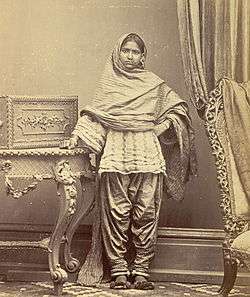Shalwar kameez
Shalwar kameez[2][3] (also salwar kameez[4] and less commonly shalwar qameez)[5][6] is a traditional combination dress worn by women, and in some regions by men, in South Asia,[4][7] and Central Asia.[8][9]
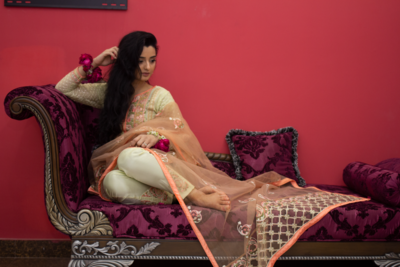
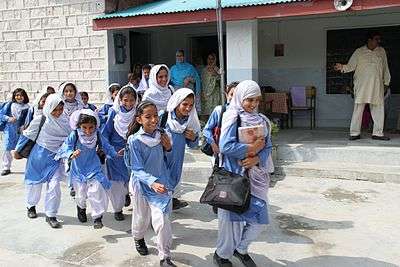
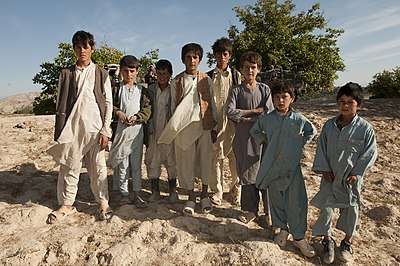
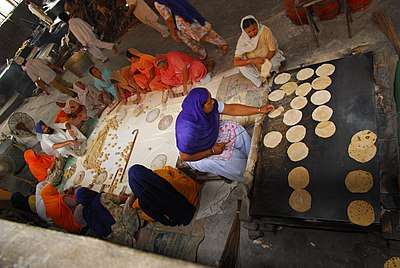
Shalwars are trousers which are atypically wide at the waist but which narrow to a cuffed bottom. They are held up by a drawstring or elastic belt, which causes them to become pleated around the waist.[4] The pants can be wide and baggy, or they can be cut quite narrow, on the bias. Shalwars have been traditionally worn in a wide region which includes Eastern Europe,[10][11] West Asia,[12][13] Central Asia, and South Asia. The kameez is a long shirt or tunic.[14] The side seams are left open below the waist-line (the opening known as the chaak[note 1]), which gives the wearer greater freedom of movement. The kameez is usually cut straight and flat; older kameez use traditional cuts; modern kameez are more likely to have European-inspired set-in sleeves. The kameez may have a European-style collar, a Mandarin-collar, or it may be collarless; in the latter case, its design as a women's garment is similar to a kurta.[16] The combination garment is sometimes called salwar kurta, salwar suit, or Punjabi suit.[17][18]
The shalwar and kameez were introduced into South Asia after the arrival of Muslims in the north in the 13th century: at first worn by Muslim women, their use gradually spread, making them a regional style,[19][20][21] especially in the historical Punjab region.[18][22][23] The shalwar-kameez is a widely-worn,[24][25] and national dress,[26] of Pakistan. It is also widely worn by men in Afghanistan,[27] and by women and some men in the Punjab region of India, from which it has been adopted by women throughout India,[28] and more generally in South Asia.[29]
When women wear the shalwar-kameez in some regions, they usually wear a long scarf or shawl called a dupatta around the head or neck.[30][31] In South Asia, the dupatta is used to display modesty: for Muslim women, the dupatta is a less stringent alternative to the chador or burqa (see hijab and purdah); for Sikh and Hindu women, the dupatta is useful when the head must be covered, as in a temple or the presence of elders.[32] Everywhere in South Asia, modern versions of the attire have evolved, the shalwars are worn lower down on the waist, the kameez have shorter length, with higher splits, lower necklines and backlines, and with cropped sleeves or without sleeves.[33]
Etymology and history
 Plate 40. TURKEY, SYRIA. PALESTINE, AND EGYPT. (Right) Wide taffeta women's trousers, tshalvar (Turkish). (1922) W. Gentz Collection
Plate 40. TURKEY, SYRIA. PALESTINE, AND EGYPT. (Right) Wide taffeta women's trousers, tshalvar (Turkish). (1922) W. Gentz Collection Plate 41. TURKEY, SYRIA, MESOPOTAMIA. Three differently cut men's trousers. ... A blue cord gathers the trousers into pleats at the bottom. (1922) Tilke Coll. and Berlin Ethnographic Museum
Plate 41. TURKEY, SYRIA, MESOPOTAMIA. Three differently cut men's trousers. ... A blue cord gathers the trousers into pleats at the bottom. (1922) Tilke Coll. and Berlin Ethnographic Museum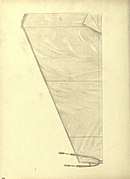 Plate 85. AFGHANISTAN. Trousers (460 cm wide) shown on this plate are not even the widest worn in Afghanistan. They are fitted in folds to the waist by knitted silk band. (1922) Origs in private collection.
Plate 85. AFGHANISTAN. Trousers (460 cm wide) shown on this plate are not even the widest worn in Afghanistan. They are fitted in folds to the waist by knitted silk band. (1922) Origs in private collection.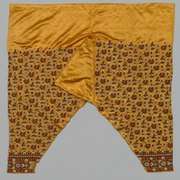 INDIA Salwar Women's trousers, Kutch, Gujarat, 19th–early 20th century, Cleveland Museum of Art.
INDIA Salwar Women's trousers, Kutch, Gujarat, 19th–early 20th century, Cleveland Museum of Art.
The English word "shalwar" derives ultimately from the Persian language. According to the "Oxford English Dictionary": its etymology is: " < Urdu šalwār, Hindi salvār, < Persian šalwār."[2] According to the Oxford Dictionary of English, it is Originally From Persian šalwār."[4] According to the Random House Unabridged Dictionary: "1880–85; < Hindi < Persian shalwār".[34] According to Steingass's A Comprehensive Persian-English Dictionary, " شلوار shalwār, shulwār, Inner breeches, drawers reaching to the feet (the outer breeches being called tuṃbān); sailorsʼ or travellersʼ trousers. شلوار بند shalwār-band, Fastening of breeches."[35] According to Shakespear's A dictionary of Hindustani and English," شلوار shalwār Persian (or shilwār) s. m. Trousers."[36] According to McGregor's Oxford Hindi English Dictionary, "शलवार śalwār (Persian: śalwār) Loose cotton trousers worn by women."[37]
 Plate 79, South CAUCASUS. Jacket (gedjalyk) and trousers (shalvar) of an Aissor. (1922). Origs. in Caucasus Museum, Tiflis
Plate 79, South CAUCASUS. Jacket (gedjalyk) and trousers (shalvar) of an Aissor. (1922). Origs. in Caucasus Museum, Tiflis Plate 90. PUNJAB Man's shirt, Cashmere. The opening for neck is Persian in shape. Man's trousers, Cashmere. Wide shape. (1922) Orig. in Berlin Ethnographic Museum
Plate 90. PUNJAB Man's shirt, Cashmere. The opening for neck is Persian in shape. Man's trousers, Cashmere. Wide shape. (1922) Orig. in Berlin Ethnographic Museum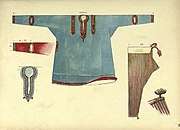 Plate 91. PUNJAB, CASHMERE. Woman's garment, Cashmere. These garments are made of diagonally woven Cashmere wool. (1922) Origs. in Berlin Ethnographic Museum
Plate 91. PUNJAB, CASHMERE. Woman's garment, Cashmere. These garments are made of diagonally woven Cashmere wool. (1922) Origs. in Berlin Ethnographic Museum ZOROASTRIAN PEOPLE: A woman's three-piece combination comprising trousers, tunic, and head-scarf, ca. 1900. Indianapolis Museum of Art.
ZOROASTRIAN PEOPLE: A woman's three-piece combination comprising trousers, tunic, and head-scarf, ca. 1900. Indianapolis Museum of Art.
The English word "kameez," derives from the Arabic language. According to the Oxford Dictionary of English, "Kameez: A long tunic worn by many people from South Asia, typically with a salwar or churidars. Origin: From Arabic qamīṣ, perhaps from late Latin camisia (see chemise)"[38] According to Wehr's A Dictionary of Modern Written Arabic: " قميص qamīs: shirt, dress, gown, covering, cover, case, wrap, envelope, jacket; plural: قمص qamus"[39] According to Steingass's A Comprehensive Persian-English Dictionary, "Arabic قميص qamīṣ, A shirt, shift, or any kind of inner garment of linen; also a tunic, a surplice (of cotton, but not of wool); the membrane which surrounds the fœtus in the womb, amnion; pericardium; a galloping horse that shakes its rider."[40] According to Platt's A Dictionary of Urdu, Classical Hindi, and English, "Arabic قميص qamīṣ, vulg. qamīz, kamīj , s.m. A shirt; a shift; a chemise (cf. It. camicia; Port. camisa).[41] According to McGregor's Oxford Hindi-English Dictionary: "क़मीज़ qamīz (Arabic: qamīş) a shirt".[42]
The English word combination "shalwar kameez," is an internationalism derived from the Urdu language; according to Patrizia Anesa, author of Lexical Innovation in World Englishes: Cross-fertilization and Evolving Paradigms, "Salwar-kameez. ... may also be described as an internationalism given its origin (Urdu). This word-formation process is based on the combination of two elements which are two garments (baggy pants and a tunic or shirt) and constitute an outfit typical of South and Central Asia."[43] Author Garland Cannon in "Problems in Studying Loans,"[note 2] in Proceedings of the 25th Annual Meeting of the Berkeley Linguistics Society, says, "... the old Urdu shalwar-kameez 'women's loose-fitting trousers and long tunic' was first used in English by colonial residents on the Indian subcontinent. (page 332)"[44][45]
Description
The shalwar are loose pajama-like trousers. The legs are wide at the top, and narrow at the ankle. The kameez is a long shirt or tunic, often seen with a Western-style collar; however, for female apparel, the term is now loosely applied to collarless or mandarin-collared kurtas. The kameez might be worn with pajamas as well, either for fashion or comfort. Some kameez styles have side seams (known as the chaak), left open below the waist-line, giving the wearer greater freedom of movement.[46]
Styles
The kameez can be sewn straight and flat, in an "A" shape design[47] or flowing like a dress; there are a variety of styles. Modern kameez styles are more likely to have European-inspired set-in sleeves. If the tailor's taste or skill is displayed, this will be seen in the shape of the neckline and the decoration of the kameez. The kameez may be cut with a deep neckline, sewn in diaphanous fabrics, or styled in cap-sleeve or sleeveless designs.
There are many styles of shalwar: the Peshawari shalwar, Balochi shalwar, Sindhi choreno and Punjabi shalwar.
Although various regions of the Indian subcontinent wear the outfit in its various forms, the outfit was originally only popular on a wide scale in Afghanistan, Khyber Pakhtunkhwa, Balochistan[48] and the Punjab region of Indian subcontinent.[49][50][51] However, the shalwar kameez has now become popular across the Indian subcontinent.[52]
Different forms
The following are some of the styles of shalwar kameez.
Anarkali suit
The shalwar kameez known as the Anarkali suit is named after the court dancer from Lahore.[53] This suit has a timeless style which has become very popular. It is made up of a long, frock-style top and features a slim fitted bottom. This style of suit links the Indian subcontinent with the women's firaq partug (frock and shalwar) of northwestern Pakistan and Afghanistan and to the traditional women's clothing of parts of Central Asia.[54] It also links to the Punjab region, where the Anarkali suit is similar to the anga[55][56] and the Peshwaz worn in Jammu.[57]
 Priyanka Chopra modeling an Anarkali suit
Priyanka Chopra modeling an Anarkali suit
Afghanistan suits
The styles of shalwar kameez worn in Afghanistan include various styles of khet partug,[58] perahan tunban and Firaq partug worn by Pashtuns, Tajiks, and Hazaras.[59] The shalwar tends to be loose and rests above the ankles.[60]
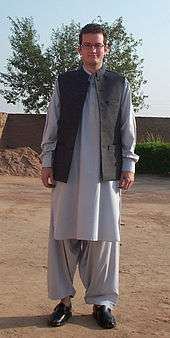 Perahan tunban worn by most Pashtun males in Afghanistan and Pakistan
Perahan tunban worn by most Pashtun males in Afghanistan and Pakistan Man in Afghan clothing: perahan tunban
Man in Afghan clothing: perahan tunban Afghan kids wearing traditional clothes in Kabul
Afghan kids wearing traditional clothes in Kabul Men wearing perahan tunban, a form of shalwar kameez at Kabul Airport in Afghanistan
Men wearing perahan tunban, a form of shalwar kameez at Kabul Airport in Afghanistan
Peshawari shalwar suit
The traditional dress of Peshawar and other parts of Khyber Pakhtunkhwa, Pakistan, is the khalqa (gown) which opens at the front,[61] or shirt which does not open at the front,[62] and the Peshawari shalwar which is very loose down to the ankles.[63] The Peshawari shalwar can be used with a number of upper garments and is part of the clothing of Khyber Pakhtunkhwa.
 Traditional Khet partug (traditional loose Peshawari shalwar)
Traditional Khet partug (traditional loose Peshawari shalwar)
Balochi suits
The clothing of Balochistan, Pakistan includes the shalwar kameez which when worn by males consists of a very baggy shalwar[64] using large lengths of cloth.[65] The kameez is also loose,[66] and traditionally is long, with long sleeves.[67] The present Balochi shalwar kameez replaced the earlier version which consisted of a robe to the ankles and a shalwar using cloth of up to 40 yards. The Pashtuns in northern Balochistan wear clothes similar to the styles worn in Afghanistan.
- Balochi male shalwar kameez, Quetta, 1867
 Traditional Balochi suits
Traditional Balochi suits Tribal elders, April 1896
Tribal elders, April 1896
The female Balochi suit consists of the head scarf, long dress and a shalwar.
 Balochi traditional dress
Balochi traditional dress.jpg) Baluchi dress
Baluchi dress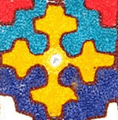 Balochi embroidery
Balochi embroidery- Traditional Balochi dresses
Phiran, poots and shalwar
In Kashmir, the outfit consists of the phiran, poots and shalwar.[68]
- Left and right: phiran shalwar; centre: Punjabi suits
 Kashmiri phiran
Kashmiri phiran A man from Srinagar wearing phiran
A man from Srinagar wearing phiran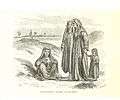 Kashmiri women in traditional long phiran 1870
Kashmiri women in traditional long phiran 1870 Kashmiri Pandits in phiran and pajama
Kashmiri Pandits in phiran and pajama Men in Kashmiri phiran and poots, 1875
Men in Kashmiri phiran and poots, 1875
Punjabi suits
The traditional shalwar kameez worn in the Punjab region is cut differently to the styles worn in Balochistan and Afghanistan and is known as a "Punjabi suit"[69][70] with the kameez being cut straight and flat with side slits[71] (which is a local development as earlier forms of kameez did not have side slits).[72] The shalwar is wide at the top but fits closely to the legs and is gathered at the ankles.[73] The Punjabi shalwar is also cut straight and gathered at the ankles with a loose band reinforced with coarse material. In rural Punjab, the shalwar is still called the suthan, which is a different garment that was popular in previous centuries,[74] alongside the churidar and kameez combination (which is still popular).[75] In Britain,[76][77] British Asian women from the Punjab region of the Indian subcontinent have brought the dress to the mainstream, and even high-fashion,[78] appeal.[79] The Punjabi suit is popular in other regions of the Indian subcontinent,[80][81][82] such as Mumbai and Sindh.[83] The popularity of Punjabi suits in India was extentuated during the 1960s through Hindi cinema.[84] Punjabi suits are also popular among young women in Bangladesh[85] and are especially popular amongst school girls in India.[86] The outfit is also popular in Afghanistan,[87] where it is called the Punjabi.[88][89][90]
 Punjabi Shalwar kameez
Punjabi Shalwar kameez Women in Punjabi suits
Women in Punjabi suits Miss Pooja of the Punjab region in a Punjabi suit
Miss Pooja of the Punjab region in a Punjabi suit- Men's Punjabi Shalwaar qamiz
.jpg) Girls arriving at school, Jammu, ca.1875-ca.1940
Girls arriving at school, Jammu, ca.1875-ca.1940 Women in ornate shalwars
Women in ornate shalwars- Rohi (Cholistan) woman's bandhani dress (Punjab, Pakistan)
 First Punjabi Wikipedia Workshop: women in Punjabi suits
First Punjabi Wikipedia Workshop: women in Punjabi suits Women wearing traditional clothes in a Punjabi kitchen: 1899
Women wearing traditional clothes in a Punjabi kitchen: 1899
The modern Punjabi shalwar kameez is the Patiala salwar which has many folds and originates in the city of Patiala.
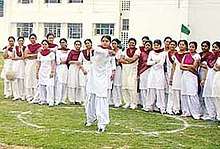 School girls wearing Patiala salwar suits
School girls wearing Patiala salwar suits
Another style of the Punjabi suit is the use of the shalwar which hails from the Pothohar region of Punjab, Pakistan and is known as the Pothohari shalwar.[75] The Pothohari shalwar retains the wideness of the older Punjabi suthan and also has some folds. The kameez is also wide. The head scarf is traditionally large,[91] similar to the chador or phulkari that was used throughout the plains of the Punjab region.[75]
Saraiki shalwar suits are Punjabi outfits which include the Bahawalpuri shalwar suit and the Multani shalwar suit.
The Bahawalpuri shalwar[92] originates from the Bahawalpur region of Punjab, Pakistan. The Bahawalpuri shalwar is very wide and baggy[93] with many voluminous folds.[94] The material traditionally used for the Bahawalpuri shalwar and suthan is known as Sufi which is a mixture of cotton warp mixed with silk weft and gold threads running down the material.[95] The other name for these types of mixed cloth is shuja khani.[96] The Bahawalpuri shalwar is worn with the Bahawalpur style kameez, the Punjabi kurta or chola.[97]
- Nawab Muhammad of Bahawalpur (1868-1900) wearing a loose Bahawalpuri shalwar
- Prince Suba Sadiq Abbasi, Bahawalpur
- Bahawalpur kameez
- Nawab Sadiq Khan Fifth (died 1966)[98] in the Bahawalpuri shalwar
The Multani shalwar, also known as the 'ghaire wali' or 'Saraiki ghaire wali' shalwar as it is very wide around the waist, originates from the Multan area of the Punjab region. The style is similar to the Sindhi kancha shalwar as both are derivatives of the pantaloon shalwar worn in Iraq[99] and adopted in these locations during the 7th century A.D.[100][101][102] The Multani shalwar is very wide, baggy,[103] and full, and has folds like the Punjabi suthan.[104] The upper garments include the Punjabi kameez and the chola of the Punjab region.[105]
An older variety of shalwar kameez of the Punjab region is the Punjabi suthan[106] and kurta suit. The Punjabi suthan is a local variation of the ancient svasthana tight fitting trousers which have been used in the Punjab region since the ancient period[107][108] and were worn with the tunic called varbana[109] which was tight fitting.
The Punjabi suthan is arranged in plaits and uses large amounts of material (traditionally coloured cotton with vertical silk lines, called sussi)[110] of up to 20 yards hanging in many folds.[111] The suthan ends at the ankles with a tight band[112][113] which distinguishes the suthan from a shalwar.[75] The modern equivalent of the loose Punjabi suthan are the cowl pants and dhoti shalwars which have many folds.
Some versions of the Punjabi suthan tighten from the knees down to the ankles (a remnant of the svasthana). If a tight band is not used, the ends of the suthan fit closely around the ankles. The Jodhpuri breeches devised during the 1870s by Sir Pratap Singh of Jodhpur[114] offer a striking slim line resemblance to the centuries-old tight Punjabi suthan, although the churidar is cited as its source.[115][116] The tight pantaloon style suthan was popular with the Indian Cavalry during the 19th and early 20th centurie; they were dyed in Multani mutti or mitti (clay/fuller's earth), which gave the garments a yellow colour.[117]
The kurta is a remnant of the 11th-century female kurtaka which was a shirt extending to the middle of the body with side slits[118] worn in parts of north India[119] which has remained a traditional garment for women in Punjab,[120] albeit longer than the kurtaka. The suthan was traditionally worn with a long kurta but can also be worn with a short kurti or frocks. Modern versions of the kurta can be knee length. The head scarf is also traditionally long but again, modern versions are shorter.
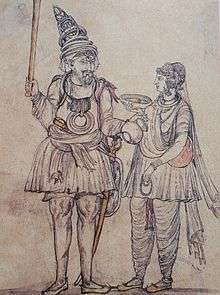 19th-century Punjabi suthan suit worn by the lady on the right
19th-century Punjabi suthan suit worn by the lady on the right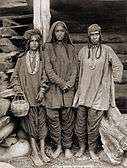 Women in Punjabi suthan 1890
Women in Punjabi suthan 1890 Woman on left in loose Punjabi suthan suit
Woman on left in loose Punjabi suthan suit Punjabi woman in Punjabi suthan and short kurta, 1874
Punjabi woman in Punjabi suthan and short kurta, 1874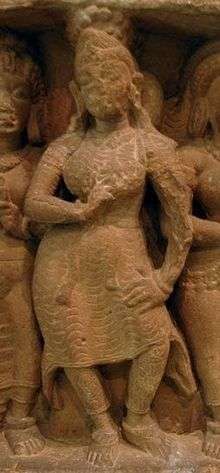 Ancient svasthana and varbana outfit worn during the Gupta Empire, the basis of the Punjabi suthan suit
Ancient svasthana and varbana outfit worn during the Gupta Empire, the basis of the Punjabi suthan suit Men in tight Punjabi suthan, 1893
Men in tight Punjabi suthan, 1893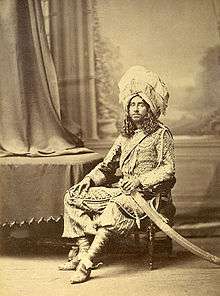 The Nawab Muhammad Bahawal Khan Abbasi V Bahadur (1883–1907) of Bahawalpur State in suthan
The Nawab Muhammad Bahawal Khan Abbasi V Bahadur (1883–1907) of Bahawalpur State in suthan Bertrand Blanchard Acosta in jodhpurs and goggles
Bertrand Blanchard Acosta in jodhpurs and goggles
The outfit in Jammu is the Dogri kurta and suthan.[121] When the tight part of the suthan, up to the knees, has multiple close fitting folds, the suthan is referred to as Dogri pants[122] or suthan, in Jammu, and churidar suthan in the Punjab region[123] and Himachal Pradesh.
 Men and boys wearing a knee length variation of the Punjabi ghuttana[124] and Dogri kurta. The full suthan is tight from the knees to the ankles, associated with the Punjab region.
Men and boys wearing a knee length variation of the Punjabi ghuttana[124] and Dogri kurta. The full suthan is tight from the knees to the ankles, associated with the Punjab region. Punjab Hills 1895, Kulu woman in churidar suthan, Himachal Pradesh
Punjab Hills 1895, Kulu woman in churidar suthan, Himachal Pradesh
Sindhi suits
The traditional Sindhi shalwar,[125] also called kancha,[126] are wide pantaloons[127] which are wide down the legs and are also wide at the ankles.[126] The Sindhi shalwar is plaited at the waist.[128] The kancha shalwar is traditionally worn with either the Sindhi cholo (blouse) by women, or a knee length robe which flares out, by men.
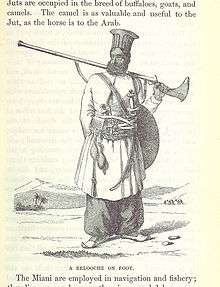 Man in Sindhi traditional Kancha shalwar.
Man in Sindhi traditional Kancha shalwar.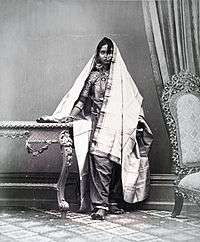 Girl from Karachi, Sindh, in a shalwar and blouse. c. 1870. Oriental and India Office Collection, British Library
Girl from Karachi, Sindh, in a shalwar and blouse. c. 1870. Oriental and India Office Collection, British Library.jpg) Man in Sindhi long angerkho(1845)
Man in Sindhi long angerkho(1845)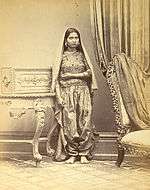 Woman, in Sind, British India, in Sindhi slim kancha shalwar
Woman, in Sind, British India, in Sindhi slim kancha shalwar
The other styles of shalwar kameez are female Sindhi suthan and cholo and male Sindhi suthan and angelo.[129]
See also
- Central Asian clothing
- Chemise
- Chikankari
- Churidar
- Dhoti
- Dupatta
- Gagra choli
- Khet partug
- Kurta
- Perahan tunban
- Kashmiri phiran and poots
- Qamis
- Sari
- Sherwani
- Sirwal
- Turkish salvar
References
Notes
Citations
- Derailing Democracy in Afghanistan: Elections in an Unstable Political Landscape, Columbia University Press, 2013, p. 178, ISBN 978-0-231-53574-8 Quote: "For example, many politicians will wear suits while in Kabul, but change into shalwar kemeez, a traditional costume of loose pants and a tunic, when returning to their home provinces to emphasize their local connections."
- "shalwar (n)", Oxford English Dictionary, Oxford University Press, retrieved 15 April 2019 (subscription required) Quote: "(Etymology: < Urdu šalwār, Hindi salvār, < Persian šalwār) Loose trousers worn by both sexes in some South Asian countries, esp. those worn by women together with a kameez. Examples: 1955 R. P. Jhabvala To whom she Will xv. 102 She was very fine now in a pink silk kamiz with blue roses on it and a pink salwar. 1957 Geogr. Mag. Aug. 198/1 A sophisticated taste will prefer the fashions of Paris and Bombay to the unbecoming qamis and shalwar of the North. 1972 H. R. F. Keating Inspector Ghote trusts Heart iii. 34 She was wearing not a sari but a bright, cherry-red kameez and salwar ".
- "kameez (n)", Oxford English Dictionary, Oxford University Press, retrieved 15 April 2019 (subscription required) Quote: "(kameez(n): In S. Asian countries, a long shirt or blouse. Examples: 1955 R. P. Jhabvala To whom she Will xv. 102 She was very fine now in a pink silk kamiz with blue roses on it and a pink salwar. 1972 ‘E. Peters’ Death to Landlords! i. 21 She had taken to the shalwar and kameez of the Punjabi women. ".
- Stevenson, Angus; Waite, Maurice (2011), Concise Oxford English Dictionary: Book & CD-ROM Set, Oxford University Press, pp. 1272–, ISBN 978-0-19-960110-3 Quote: "Salwar/Shalwar: A pair of light, loose, pleated trousers, usually tapering to a tight fit around the ankles, worn by women from South Asia typically with a kameez (the two together being a salwar kameez). Origin From Persian and Urdu šalwār."
- Donnan, Hastings (1991), Economy and Culture in Pakistan: Migrants and Cities in a Muslim Society, Palgrave Macmillan UK, p. 149, ISBN 978-1-349-11401-6 Quote: "... wearing shalwar qameez, Pakistan's national dress of baggy trousers and loose knee-length shirt."
- Lewis-Beck, Michael; Bryman, Alan E; Liao, Tim Futing (2003), The SAGE Encyclopedia of Social Science Research Methods, SAGE Publications, p. 188, ISBN 978-1-4522-6145-4 Quote: "Shalwar qameez (Pakistani clothes)"
- "shalwar-kameez", Longman's Dictionary of Contemporary English Quote: "loose trousers which are narrow at the bottom and a long loose shirt, worn by some South Asian women and, in some countries, men."
- Anesa, Patrizia (2018), Lexical Innovation in World Englishes: Cross-fertilization and Evolving Paradigms, Taylor & Francis, p. 178, ISBN 978-1-351-10933-8 Quote: "Other compounds are, for instance, ... salwar-kameez. ... It may also be described as an internationalism given its origin (Urdu). This word-formation process is based on the combination of two elements which are two garments (baggy pants and a tunic or shirt) and constitute an outfit typical of South and Central Asia."
- Farrar, Max; Valli, Yasmin (2012), Islam in the West: Key Issues in Multiculturalism, Palgrave Macmillan UK, p. 101, ISBN 978-1-137-02506-7 Quote: "A 'Shalwar Kameez' is a form of dress worn by both men and women in South and Central Asia, combining a long shirt worn over loose fitting tapered trousers."
- Gavrilova, Raĭna; Gavrilova, Rajna D. (1999), Bulgarian Urban Culture in the Eighteenth and Nineteenth Centuries, Susquehanna University Press, pp. 145–, ISBN 978-1-57591-015-4
- Cole, Jeffrey E. (2011), Ethnic Groups of Europe: An Encyclopedia: An Encyclopedia, ABC-CLIO, pp. 289–, ISBN 978-1-59884-303-3
- Scarce, Jennifer M. (2014), Women's Costume of the Near and Middle East, Routledge, p. 73, ISBN 978-1-136-78385-2
- Gole, Nilufer; Göle, Nilüfer (1996), The Forbidden Modern: Civilization and Veiling, University of Michigan Press, pp. 60–, ISBN 0-472-06630-7
- Stevenson, Angus; Waite, Maurice (2011), Concise Oxford English Dictionary: Book & CD-ROM Set, Oxford University Press, p. 774, ISBN 978-0-19-960110-3 Quote: "Kameez: A long tunic worn by many people from South Asia, typically with a salwar or churidars. Origin: From Arabic qamīṣ, perhaps from late Latin camisia (see chemise)".
- Platts, John T. (John Thompson) (1884), A dictionary of Urdu, classical Hindi, and English, London: W. H. Allen & Co., p. 418 (online; updated February 2015)
- Stevenson, Angus; Waite, Maurice (2011), Concise Oxford English Dictionary: Book & CD-ROM Set, Oxford University Press, p. 792, ISBN 978-0-19-960110-3 Quote: "A loose collarless shirt worn by people from South Asia. Origin: From Urdu and Persian kurtah."
- Shukla, Pravina (2015), The Grace of Four Moons: Dress, Adornment, and the Art of the Body in Modern India, Indiana University Press, pp. 75–, ISBN 978-0-253-02121-2 Quote: "You can buy an entire three-piece salwar suit, or a two-piece suit that consists of either a readymade kurta or a kurta cloth piece, each with a matching dupatta. For these, you must have the salwar pants stitched from cloth you buy separately. A third option would be to buy a two-piece ensemble, consisting of the top and pants, leaving you the task of buying an appropriate dupatta, or using one you already own, or buying a strip of cloth and having it dyed to your desire. The end result will always be a three-piece ensemble, but a customer may start with one piece (only the kurta) or two pieces (kurta and pants, or kurta and dupatta), and exercise her creativity and fashion sense to end up with the complete salwar kurta outfit. (page 75)"
- Mooney, Nicola (2011), Rural Nostalgias and Transnational Dreams: Identity and Modernity Among Jat Sikhs, University of Toronto Press, pp. 260–, ISBN 978-0-8020-9257-1 Quote: "The salwar-kameez is a Muslim form of dress that has been adopted widely in Punjab and is now known in English as the Punjabi suit; J.P.S. Uberoi suggests that the salwar-kameez is an Afghani import to Punjab (1998 personal communication). Punjabi forms of dress are therefore constructs or inventions of tradition rather than having historical veracity."
- Tarlo, Emma (1996), Clothing Matters: Dress and Identity in India, Chicago and London: University of Chicago Press, p. 28, ISBN 978-0-226-78976-7 Quote: "The comparatively limited range of stitched clothes available in pre-medieval India was, however, greatly expanded during the Sultanate and Moghul periods when various types of trousers, robes and tunics gained in popularity (Chaudhuri 1976: 51). ... Muslim women generally wore a veil (dupata), a long tunic (kamiz) with trousers (shalwar) or the wide flared skirt-like trouser (gharara). Following the Muslim conquest of northern India, many Hindu women gradually adopted such dress, eventually making it the regional style for parts of Northern India. (page 28)"
- Tarlo, Emma (1996), Clothing Matters: Dress and Identity in India, University of Chicago Press, p. 133, ISBN 978-0-226-78976-7 Quote: "The shalwar kamiz, though introduced to India by Muslims, has been worn for centuries by both Hindus and Muslims in parts of northern India (see chapter 2). It has recently become the acceptable garb of female college students of all religions throughout the subcontinent. However, once married, Hindu women often revert to saris unless they either live in the far northern states or belong to a cosmopolitan urban elite. In most rural areas, the shalwar kamiz has retained its Islamic associations more strongly than in cities and is worn only by the educated few."
- Sun, Ming-Ju (2001), Traditional Fashions from India Paper Dolls, Courier Corporation, pp. 19–, ISBN 978-0-486-41328-0 Quote: "Much of traditional Indian women's clothing changed in the 12th century, when Muslims conquered north and central India. New dress styles were developed to cover the body as much as possible, befitting Islamic preferences. One option was a costume of wide-legged trousers (salwar) snugly fitted around the calves, worn with a long tunic (kameez) and short, fitted jacket."
- Fraile, Sandra Santos (11 July 2013), "Sikhs in Barcelona", in Blanes, Ruy; Mapril, José (eds.), Sites and Politics of Religious Diversity in Southern Europe: The Best of All Gods, BRILL, pp. 263–, ISBN 978-90-04-25524-1 Quote: "The shalwar kamiz was worn traditionally by Muslim women and gradually adopted by many Hindu women following the Muslim conquest of northern India. Eventually, it became the regional style for parts of northern India, as in Punjab where it has been worn for centuries. (page 263)"
- Shome, Raka (2014), Diana and Beyond: White Femininity, National Identity, and Contemporary Media Culture, University of Illinois Press, pp. 102–3, ISBN 978-0-252-09668-6 Quote: "The salwar kameez entered India (when Pakistan, Bangladesh, and current-day India together made up India or the British Raj) as early as 12th century through Mughal (Muslim) invasions from Central and West Asia. India and Pakistan have a strong Persian influence. Until before India's independence from the British, it is Muslim women (and men) in the then British Raj (the term used to refer to India before independence) who primarily wore the salwar kameez, although there were gender and regional variations in style. After Pakistan/Indian independence from the British, the salwar kameez became an everyday clothing item especially for North Indian women (including Sikh women, although Sikhs are not Muslims) and Pakistani women because the influence of Muslim culture was the strongest in Pakistan and North India around the time of independence."
- Marsden, Magnus (2005), Living Islam: Muslim Religious Experience in Pakistan's North-West Frontier, Cambridge University Press, pp. 37–, ISBN 978-1-139-44837-6 Quote: "The village's men and boys largely dress in sombre colours in the loose trousers and long shirt (shalwar kameez) worn across Pakistan. Older men often wear woollen Chitrali caps (pakol), waistcoats and long coats (chugha), made by Chitrali tailors (darzi) who skills are renowned across Pakistan."
- Haines, Chad (2013), Nation, Territory, and Globalization in Pakistan: Traversing the Margins, Routledge, pp. 162–, ISBN 978-1-136-44997-0 Quote: "the shalwar kameez happens to be worn by just about everyone in Pakistan, including in all of Gilgit-Baltistan."
- Ozyegin, Gul (2016), Gender and Sexuality in Muslim Cultures, Routledge, pp. 222–, ISBN 978-1-317-13051-2 Quote: "What is common in all the cases is the wearing of shalwar, kameez, and dupatta, the national dress of Pakistan."
- Johnson, Thomas H. (2018). Taliban Narratives: The Use and Power of Stories in the Afghanistan Conflict. Oxford University Press. pp. 249–. ISBN 978-0-19-091167-6. Quote: "The leaflet shows an Afghan maile dressed in usual attire—a shalwar kameez and woolen hat, or pakol."
- Khandelwal, Madhulika Shankar (2002), Becoming American, Being Indian: An Immigrant Community in New York City, Cornell University Press, pp. 43–, ISBN 0-8014-8807-9 Quote: "Even highly educated women pursuing careers continue to wear traditional dress in urban India, although men of similar status long ago adopted Western attire. The forms of dress most popular with urban Indian women are the sari, the long wrapped and draped dress-like garment, worn throughout India, and the salwar-kameez or kurta-pyjama, a two-piece suit garment, sometimes also called Punjabi because of its region of origin. Whereas the sari can be considered the national dress of Indian women, the salwar-kameez, though originally from the north, has been adopted all over India as more comfortable attire than the sari.
- Condra, Jill (2013). Encyclopedia of National Dress: Traditional Clothing around the World. ABC-CLIO. p. 570. ISBN 9780313376375.
Today, throughout India and especially in the northern regions and in larger cities such as Delhi, the shalwar kameez is worn frequently by Muslims and non-Muslims alike; the style for women has been widely adopted as an alternative to the sari and to Western clothing, particularly by college-age and unmarried young women. ... The kurta for men is similar in form and style to the shalwar kameez. The kurta, or tunic-length shirt, is collarless or has a mandarin- or Nehru style collar.
- Farrar, Max; Valli, Yasmin (2012), Islam in the West: Key Issues in Multiculturalism, Palgrave Macmillan UK, p. 101, ISBN 978-1-137-02506-7 Quote: "The women's form of Shalwar Kameez is usually accompanied by a scarf or `dupatta' which can be worn around the neck, covering the chest area for 'modesty' or over the hair as a head covering."
- Ozyegin, Gul (2016), Gender and Sexuality in Muslim Cultures, Routledge, pp. 222–, ISBN 978-1-317-13051-2 Quote: "a dupatta is a long, wide piece of cloth measuring approximately 2-2.5 meters long and 1 meter wide."
- Shukla, Pravina (2015). The Grace of Four Moons: Dress, Adornment, and the Art of the Body in Modern India. Indiana University Press. pp. 72–. ISBN 978-0-253-02121-2. Quote: "Muslim and Punjabi women—whether Muslim, Sikh, or Hindu—often wear the dupatta over the head to create a modest look while framing the face with color. When entering a temple, Hindu women might comparably use their dupattas to cover their heads. Though the dupatta is often made of flimsy cloth and does not actually cover the body, its presence implies modesty, like many of the outer garments worn by Muslim women that do not cover much but do provide a symbolic extra layer, ..."
- Koerner, Stephanie (2016), Unquiet Pasts: Risk Society, Lived Cultural Heritage, Re-designing Reflexivity, Taylor & Francis, pp. 405–, ISBN 978-1-351-87667-4 Quote: "The Pakistani National dress worn by women is Shalwar Kameez. This consists of a long tunic (Kameez) teamed with a wide legged trouser (Shalwar) that skims in at the bottom accompanied by a duppata, which is a less stringent alternative to the burqa. Modern versions of this National dress have evolved into less modest versions. Shalwar have become more low cut so that the hips are visible and are worn with a shorter length of Kameez which has high splits and may have a lowcut neckline and backline as well as being sleeveless or having cropped sleeves. "
- "Shalwar". Dictionary.com. Retrieved 2 May 2019.
- Steingass, Francis Joseph (1892), A Comprehensive Persian-English dictionary, including the Arabic words and phrases to be met with in Persian literature, London: Routledge & K. Paul online; last updated 2007
- Shakespear, John (1834), A dictionary, Hindustani and English: with a copious index, fitting the work to serve, also, as a dictionary of English and Hindustani. 3rd ed., much enl., London: Printed for the author by J.L. Cox and Son: Sold by Parbury, Allen, & Co. online, updated 2008
- McGregor, Ronald Stuart (1993), The Oxford Hindi-English Dictionary, Oxford University Press, p. 945, ISBN 978-0-19-563846-2
- Stevenson, Angus (2010), Oxford Dictionary of English, Oxford University Press, p. 955, ISBN 978-0-19-957112-3
- Wehr, Hans (1979), A Dictionary of Modern Written Arabic, Otto Harrassowitz Verlag, pp. 924–, ISBN 978-3-447-02002-2
- Steingass, Francis Joseph (1892), A Comprehensive Persian-English Dictionary: Including the Arabic Words and Phrases to be Met with in Persian Literature, London: Routledge & K. Paul, pp. 989–
- Platts, John T. (John Thompson) (1884), A dictionary of Urdu, classical Hindi, and English, London: W. H. Allen & Co., p. 795 (online; updated February 2015)
- McGregor, Ronald Stuart (1993), The Oxford Hindi-English Dictionary, Oxford University Press, ISBN 978-0-19-864339-5
- Anesa, Patrizia (2018), Lexical Innovation in World Englishes: Cross-fertilization and Evolving Paradigms, Taylor & Francis, p. 178, ISBN 978-1-351-10933-8
- Garland Cannon (2000), "Problems in Studying Loans", Proceedings of the 25th Annual Meeting of the Berkeley Linguistics Society: 326–336
- Garland Cannon (1997), "90 post-1949 Arabic loans in written English", Word, 48 (2): 171–194, doi:10.1080/00437956.1997.11432466 Quote: Shalwar-kameez is an old English loanword still used in Urdu to denote women's loose-fitting trousers and long tunic. Its reappearance by 1955 to denote roughly the same sense can raise the question of whether there is not simply a revival of a word once commonly used by British expatriates on the subcontinent, except that it is now extended to this attire as used in the West. (page 183)"
- Koerner, Stephanie; Russell, Ian (2010-08-16). Unquiet Pasts: Risk Society, Lived Cultural Heritage, Re-Designing Reflexivity – Stephanie Koerner, Ian Russell – Google Books. ISBN 9780754675488. Retrieved 2012-06-14.
- Padmavati, B (2009) Techniques Of Drafting And Pattern Making Garments For Kids And Adolescents
- Jānmahmad (1 January 1982). "The Baloch cultural heritage". Royal Book Co. – via Google Books.
- Condra, Jill (2013). Encyclopedia of National Dress: Traditional Clothing Around the World.
- "Social Science a Textbook in History for Class IX as per New Syllabus". FK Publications – via Google Books.
- Sumathi, G. J. (1 January 2007). Elements of Fashion and Apparel Design. New Age International. ISBN 9788122413717 – via Google Books.
- Rutnagur, Sorabji. M (1996) The Indian Textile Journal, Volume 106, Issues 9-12
- Condra, Jill (2013) Encyclopedia of National Dress: Traditional Clothing Around the World
- Condra, Jill (2013) Encyclopedia of National Dress: Traditional Clothing Around the World
- B. N. Goswamy, Kalyan Krishna, Tarla P. Dundh (1993) Indian Costumes in the Collection of the Calico Museum of Textiles, Volume 5
- Punjab District Gazetteers – District Attock Year Published 1930 BK-000211-0160
- Kumar, Raj (2006) Paintings and Lifestyles of Jammu Region: From 17th to 19th century A.D.
- R. T. I. (Richard Thomas Incledon) Ridgway (1997) Pashtoons: History, Culture & Traditions
- University, Brigham Young; Learning, ProQuest Information and; Company, ProQuest Information and Learning (1 August 2004). CultureGrams. ISBN 9781931694896 – via Google Books.
- "Gurmukhi e-Book : Shayed Rammi Mann Jaye Te Hor Kahanian ; Pure". apnaorg.com.
- North-West Frontier Province (Pakistan). Information Dept Yearbook (1955)
- Peshawar, University of (1 January 1952). "Journal of the University of Peshawar" – via Google Books.
- Captain Hastings, E. G. G. (1878) Report of the regular settlement of the peshawar district of the punjab
- Postans, Thomas (1843) Personal Observations on Sindh: The Manners and Customs of Its Inhabitants; and Its Productive Capabilities
- "Balochi dress – Male". 12 March 2013.
- Nadiem, Ihsan H. (December 18, 2007). Balochistan: Land, History, People. Sang-e-Meel Publications. ISBN 9789693520231 – via Google Books.
- DostPakistan.pk but now can also be knee length.
- Malik, S. And Sahgal. Gettingahead In Social Studies. Orient Blackswan. ISBN 9788125022244 – via Google Books.
- Irani, Tannaaz (10 December 2014). THE ARMCHAIR CRITIC: Chafes and Chuckles. Cresco Books. ISBN 9788192969244 – via Google Books.
- Marwaha, Pritpal (2012) Shakahaari: The Vegetarian Gourmet Fine, Authentic Indian Vegetarian Cuisine
- Cooke, David Coxe (1 January 1967). "Dera, a village in India". W.W. Norton – via Google Books.
- Madani, Mohsen Saeidi (1 January 1993). "Impact of Hindu Culture on Muslims". M.D. Publications Pvt. Ltd. – via Google Books.
- Kumar, Raj (2006) Paintings and Lifestyles of Jammu Region: From 17th to 19th century A.D
- Panjab University Research Bulletin: Arts, Volume 13, Issue 1 – Volume 14, Issue (1982)
- Mohinder Singh Randhawa. (1960) Punjab: Itihas, Kala, Sahit, te Sabiachar aad.Bhasha Vibhag, Punjab, Patiala.
- Breidenbach, Pál & Zcaronupanov 2004 Quote: "And in Bubby Mahil’s fashion store in London, white socialites and young British Asians shop for the Punjabi suits".
- Walton-Roberts & Pratt 2005. Quote: "Meena owns a successful textile design and fashion business in the Punjab, designing and selling high-end salwar kameez (Punjabi suits) ..."
- Sheikh, Ibriz (27.05.2015) 'Dress over pants': Rest of the world finally catches on to Shalwar kameez trend
- Bachu 2004
- Sorabji M. Rutnagur (1996) The Indian Textile Journal, Volume 106, Issues 9-12
- McGilvray, Dennis B. (2008)Crucible of Conflict: Tamil and Muslim Society on the East Coast of Sri Lanka
- Saikia, Yasmin (2011). Women, War, and the Making of Bangladesh: Remembering 1971. Duke University Press. p. 274. ISBN 978-0-8223-5038-5.
- Bakshi, SHri Ram (1992) Struggle for Independence: Vijaya Lakshmi Pandit
- Ṿai, Shalṿah (2002) India's Jewish heritage: ritual, art & life-cycle. Marg Publications
- Alex Newton, Betsy Wagenhauser, Jon Murray (1996) Bangladesh: A Lonely Planet Travel Survival Kit
- (India), Madhya Pradesh (1 January 1965). "Madhya Pradesh district gazetteers". Govt. Central Press – via Google Books.
- Emadi, Hafizullah (1 January 2005). "Culture and Customs of Afghanistan". Greenwood Publishing Group – via Google Books.
- "Afghanistan Clothing, Afghan or Afghani Traditional Clothes". www.afghanistan-culture.com.
- Staples, Suzanne Fisher (2008) Under the Persimmon Tre. Farrar, Straus and Giroux (BYR
- Pia Karlsson, Amir Mansory (2007) An Afghan dilemma: education, gender and globalisation in an Islamic context. Institute of International Education, Department of Education, Stockholm University
- "Culture and Traditions of Kashmir". cultureandtraditionsofkashmir.blogspot.co.uk.
- (Firm), Cosmo Publications (1 January 2000). "The Pakistan gazetteer". Cosmo Publications – via Google Books.
- "Current Opinion". Current Literature Publishing Company. 1 January 1899 – via Google Books.
- Prior, Katherine; Admson, John (1 January 2001). "Maharajas' Jewels". Mapin Pub. – via Google Books.
- Extracts from the District & States Gazetteers of the Punjab, Pakistan, Volume 2 (1976)
- (Firm), Cosmo Publications (1 January 2000). "The Pakistan gazetteer". Cosmo Publications – via Google Books.
- 1998 District Census Report of [name of District].: Lodhran (1999)
- "The All-Pakistan Legal Decisions". All-Pakistan Legal Decisions. 1 January 1984 – via Google Books.
- "Islamic Culture: The Hyderabad Quarterly Review". Deccan. 1 January 1979 – via Google Books.
- Kumar, Raj (2008) Encyclopaedia of Untouchables Ancient, Medieval and Modern
- Sawindara Siṅgha Uppala (1966) Panjabi short story: its origin and development
- Chandra, Moti (1973) Costumes, Textiles, Cosmetics & Coiffure in Ancient and Mediaeval India
- Chaudhry, Nazir Ahmad (2002) Multan Glimpses: With an Account of Siege and Surrender
- "Glossary of the Multani Language, Or, Southwestern Panjabi". Printed at the Punjab Government Press. 1 January 1903 – via Google Books.
- O'Brien, Edward (1881) Glossary of the Multani Language Compared with Punjábi and Sindhi
- (India), Haryana (1 January 1988). "Haryana District Gazetteers: Sirsa". Haryana Gazetteers Organization – via Google Books.
- Aniruddha Ray, Kuzhippalli Skaria Mathew (2002) Studies in history of the Deccan: medieval and modern : Professor A.R. Kulkarni felicitation volume
- A. V. Narasimha Murthy, K. V. Ramesh (1987) Giridharaśrī: essays on Indology : Dr. G.S. Dikshit felicitation volume
- "Mārg̲". J. J. Bhabha for Marg Publications. 1 January 1969 – via Google Books.
- Punjab District Gazetteer: Reprint of Ludhiana District and Malerkotla State Gazetteer, 1904
- Punjab District Gazetteers (1932)Punjab District Gazetteers (1932)
- dept, Punjab revenue (1 January 1876). Land revenue settlement reports – via Internet Archive.
kurta.
- General, India Office of the Registrar (1 January 1961). "Census of India, 1961". Manager of Publications – via Google Books.
- Singh, Jaisal (1 January 2007). Polo in India. New Holland Publishers. ISBN 9781845379131 – via Google Books.
- Biswas, Arabinda; Division, India Ministry of Information and Broadcasting Publications (1 January 1985). "Indian Costumes". Publ. Division, Ministry of Information and Broadcasting – via Google Books.
- "Country Life". Country Life, Limited. 1 January 2001 – via Google Books.
- Carman, W. Y. (1961) Indian Army Uniforms Under the British: From the 18th century to 1947
- Ghurye, Govind Sadashiv (1 January 1966). Indian Costume. Popular Prakashan. ISBN 9788171544035 – via Google Books.
- Yadava, Ganga Prasad (1982) Dhanapāla and His Times: A Socio-cultural Study Based Upon His Works
- Sharma, Brij Narain (1966) Social life in Northern India, A.D. 600-1000
- D. N. Saraf (1987) Arts and Crafts, Jammu and Kashmir: Land, People, Culture
- Umran, Khan (14 February 2010). "Indian Ethnic Wear". ethniccode.com. India: Ethnic Code. pp. 9–10. Retrieved 19 September 2016.
- Baden Henry Baden-Powell (1872) Hand-book of the Manufactures & Arts of the Punjab: With a Combined Glossary & Index of Vernacular Trades & Technical Terms ... Forming Vol. Ii to the "Hand-book of the Economic Products of the Punjab" Prepared Under the Orders of Government
- Kumar, Ritu (14 July 2006). "Costumes and textiles of royal India". Antique Collectors' Club – via Google Books.
- Pathan, Mumtaz Husain (1 January 1974). "Arab kingdom of al-Mansurah in Sind". Institute of Sindhology, University of Sind – via Google Books.
- Burton, Richard (1996) Sindh and the Races that Inhabit the Valley of the Indus: With Notices of the Topography and History of [the] Province
- Kumar, Raj (1 January 2008). "Encyclopaedia of Untouchables Ancient, Medieval and Modern". Gyan Publishing House – via Google Books.
- Reginald Edward Enthoven, Stephen Meredyth Edwardes (1909) Provincial series: Bombay presidency ...
- (Pakistan), Population Census Organisation (1 January 2000). "1998 provincial census report of [name of province]". Population Census Organization, Statistics Division, Govt. of Pakistan – via Google Books.
Bibliography
- Bachu, Parminder (2004), Dangerous Designs: Asian Women Fashion the Diaspora Economies, London: Routledge. Pp. xii, 196, ISBN 0415072212, archived from the original on December 31, 2008
- Breidenbach, Joana; Pál, Nyíri; Zcaronupanov, Ines (2004), "Fashionable Books", Identities: Global Studies in Power and Culture, 11 (4): 619–628, doi:10.1080/10702890490883885
- Walton-Roberts, Margaret; Pratt, Geraldine (2005), "Mobile Modernities: One South Asian Family Negotiates Immigration, Gender and Class in Canada", Gender, Place & Culture, 12 (2): 173–195, doi:10.1080/09663690500094823.
External links
| Wikimedia Commons has media related to Shalwar kameez. |
